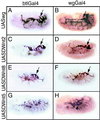Seven Wnt homologues in Drosophila: a case study of the developing tracheae
- PMID: 11717401
- PMCID: PMC64708
- DOI: 10.1073/pnas.251304398
Seven Wnt homologues in Drosophila: a case study of the developing tracheae
Abstract
Sequencing of the Drosophila genome has revealed that there are "silent" homologues of many important genes-family members that were not detected by classic genetic approaches. Why have so many homologues been conserved during evolution? Perhaps each one has a different but important function in every system. Perhaps each one works independently in a different part of the body. Or, perhaps some are redundant. Here, we take one well known gene family and analyze how the individual members contribute to the making of one system, the tracheae. There are seven DWnt genes in the Drosophila genome, including wingless (wg). The wg gene helps to pattern the developing trachea but is not responsible for all Wnt functions there. We test each one of the seven DWnts in several ways and find evidence that wg and DWnt2 can function in the developing trachea: when both genes are removed together, the phenotype is identical or very similar to that observed when the Wnt pathway is shut down. DWnt2 is expressed near the tracheal cells in the embryo in a different pattern to wg but is also transduced through the canonical Wnt pathway. We find that the seven DWnt genes vary in their effectiveness in specific tissues, such as the tracheae, and, moreover, the epidermis and the tracheae respond to DWnt2 and Wg differently. We suggest that the main advantage of retaining a number of similar genes is that it allows more subtle forms of control and more flexibility during evolution.
Figures





Similar articles
-
DWnt-4 and Wingless have distinct activities in the Drosophila dorsal epidermis.Dev Genes Evol. 2000 Mar;210(3):111-9. doi: 10.1007/s004270050017. Dev Genes Evol. 2000. PMID: 11180811
-
Antagonist activity of DWnt-4 and wingless in the Drosophila embryonic ventral ectoderm and in heterologous Xenopus assays.Mech Dev. 1999 Jul;85(1-2):123-31. doi: 10.1016/s0925-4773(99)00097-0. Mech Dev. 1999. PMID: 10415353
-
Drosophila Twins regulates Armadillo levels in response to Wg/Wnt signal.Development. 2004 Mar;131(5):1007-16. doi: 10.1242/dev.00980. Development. 2004. PMID: 14973271
-
Pygopus and the Wnt signaling pathway: a diverse set of connections.Bioessays. 2008 May;30(5):448-56. doi: 10.1002/bies.20757. Bioessays. 2008. PMID: 18404694 Review.
-
Drosophila wingless: a paradigm for the function and mechanism of Wnt signaling.Bioessays. 1994 Jun;16(6):395-404. doi: 10.1002/bies.950160607. Bioessays. 1994. PMID: 8080429 Review.
Cited by
-
Genome-Wide Identification and Expression Profiling of Wnt Family Genes in the Silkworm, Bombyx mori.Int J Mol Sci. 2019 Mar 11;20(5):1221. doi: 10.3390/ijms20051221. Int J Mol Sci. 2019. PMID: 30862048 Free PMC article.
-
Combinatorial Signal Perception in the BMP Pathway.Cell. 2017 Sep 7;170(6):1184-1196.e24. doi: 10.1016/j.cell.2017.08.015. Cell. 2017. PMID: 28886385 Free PMC article.
-
Pattern recognition in living cells through the lens of machine learning.Open Biol. 2025 Jul;15(7):240377. doi: 10.1098/rsob.240377. Epub 2025 Jul 16. Open Biol. 2025. PMID: 40664239 Free PMC article. Review.
-
Molecular mechanisms of tubulogenesis revealed in the sea star hydro-vascular organ.Nat Commun. 2023 May 9;14(1):2402. doi: 10.1038/s41467-023-37947-2. Nat Commun. 2023. PMID: 37160908 Free PMC article.
-
The Wnt Co-Receptor PTK7/Otk and Its Homolog Otk-2 in Neurogenesis and Patterning.Cells. 2024 Feb 20;13(5):365. doi: 10.3390/cells13050365. Cells. 2024. PMID: 38474329 Free PMC article.
References
Publication types
MeSH terms
Substances
LinkOut - more resources
Full Text Sources
Other Literature Sources
Medical
Molecular Biology Databases

